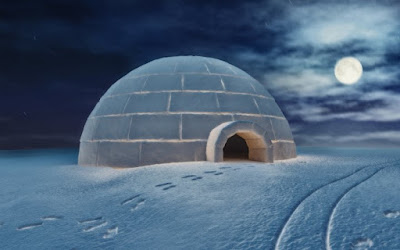For thousands of years, humans, and plants and animals long
before that, have been using frozen “sky water” to keep warm, which sort of
doesn’t make sense. Because snow is cool. You might even say it’s… ice cold.
YEEAAHHHHH! No one knows for sure who built the first igloo, but with the right
fit and the right physics, snow can actually warm you better than the inside of
a tauntaun. So, how can something cold keep you cozy?
The vast, frozen Arctic is one of the most forbidding
environments on our planet, yet, the Inuit have managed to live there for about
5,000 years. Out on the pack ice, winter temperatures reach 50 degrees below
zero, and when it’s that cold, surviving means finding shelter. It’s not an
area known for its forests, so nomadic hunters learned to build with the only
thing available: snow.
Eskimo languages really do have dozens and dozens of
different words for snow, because there are a lot of different types, and the
type of snow you choose can dictate whether your igloo keeps you warm, or turns
you into a Homo sapiensicle.
To understand this, we need to know a little something about
being cold. When your body temperature starts to plummet – you’re feeling heat
leave you. Cold can’t move into your body – in fact, there is no such thing as
cold. Think of heat as an actual quantity of stuff:. The more you give away,
the colder you feel. This trading of heat can happen three different ways: by convection, conduction, and radiation. All three are at play in an
igloo. A person inside will radiate body heat, which moves around the igloo by
convection, and is lost through the walls by conduction. This is exactly what
happens in your house.
Living insulation does the same thing. Fatty tissues like
blubber help stop heat transfer in whales and seals, but for animals who don’t
have as much junk in the trunk, they cover themselves in air. Sea otter fur,
for example, is about a thousand times denser than human hair. It’s snuggly stuff
but the secret to its insulation power is in its texture. Otter fur is spiky,
so it traps insulating air molecules.
That is exactly what snowflakes do. Powdery, fresh snow can
be up to 95% trapped air. This makes it an excellent insulator, but the same
way you have to pack it in your hands to make a snowball, it isn’t dense enough
to build with. Solid ice, on the other hand, makes a good windbreaker, but it’s
too heavy to lift. Inuit hunters took the Goldilocks approach: the secret to
good igloo snow is somewhere in the middle.
Traditional igloo
blocks aren’t molded, they’re cut out of the ground. That tightly-packed ground
snow is dense enough to hold up, but because it still has far more air pockets
than a block of ice, it’s light, and still a pretty good insulator.
As usual, animals figured this one out long before humans.
Polar bears, groundhogs, even birds like grouse all make snow burrows to stay
warm. And even before that, plants were tucking into snow to avoid death by
freezing.
During the warm months, heat energy from the sun builds up in
soil, and just like the the roof above your head, a deep covering of snow
prevents that heat from escaping onward and upward. This snowy blanket above
stops ice crystals from forming inside plant roots, and shoots, and seeds.
Not freezing to death is a pretty good motivator for any
animal to get crafty, but our big primate brains took it one step further with
igloos. Their engineering maximizes warmth and stability. Cartoon igloos look
like flat-bottomed half-spheres, but in reality, they’re neither of those
things! If you were to slice a real igloo in half, you’d see a shape called a catenary.
This gradually sloping shape is the same one that would form
if you held a chain from both ends and let it droop. A catenary arch
distributes weight more evenly than a half circle, without bulging or buckling.
In fact it’s one of the most stable arches in nature, so sound that we still
use it today.
Inside, snow houses are carved in different levels. The hot
air rises, and the cold air sinks down into the lower part, and away from where
you would eat, sleep, and chill.
To boot, body heat melts the innermost layer of the walls,
strengthening the barrier between you, your airy snow-block insulation, and the
frigid great beyond. When you live in an igloo, you act as a living furnace.
Over time, the temperature in your icy abode can hover some 40-60 degrees above
the surrounding air, but bring a friend to your igloo party, and you’ll get
warmer, faster.




No comments:
Post a Comment